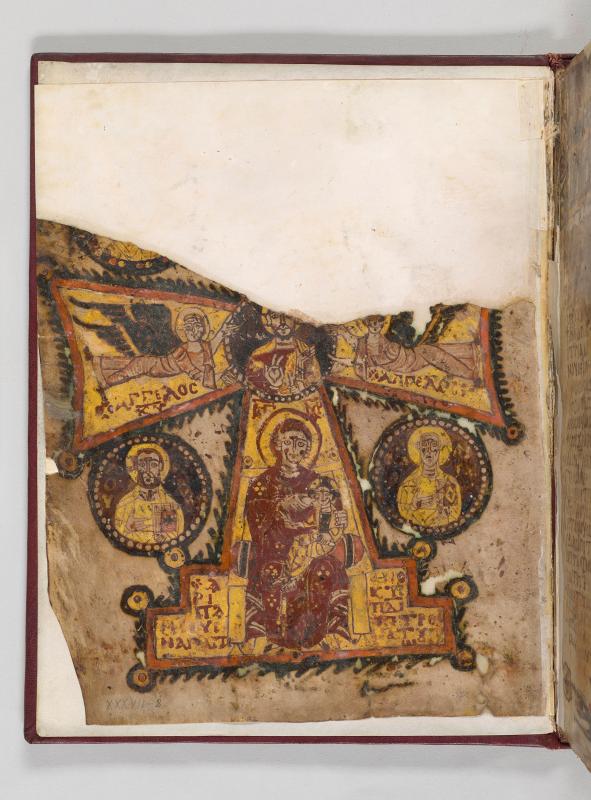
Accession number
MS M.600
Object title
Hagiographic and homiletic Miscellany.
Created
Touton scriptorium, Fayyūm Province, Egypt, 905-906
Binding
Ancient binding: According to Petersen the upper and lower covers, and the greater portion of the back of the ancient binding was leather over papyrus boards. (Binding cataloged separately as MS M.600A.)
Credit line
Purchased for J. Pierpont Morgan (1837-1913) in 1911.
Description
64 leaves (2 columns, 31 lines), bound : vellum, ill. ; 353 x 274 mm
Provenance
Donated to the Monastery of Saint Michael (Dayr al-Malāk Mīkhāʼil) on AM 622 (Aug. 29, 905 or Aug. 28, 906); found in 1910 near the village of Hamuli, Fayyūm Province, Egypt, at the site of the Monastery of Saint Michael; purchased in Paris in 1911 for J. Pierpont Morgan (1837-1913) from Arthur Sambon, a dealer acting in behalf of a consortium of owners including a certain J. Kalebdian; J.P. Morgan (1867-1943).
Notes
Manuscript hagiographic and homiletic miscellany; written and illuminated at the Touton scriptorium, the Fayyūm Province, Egypt, between 905 and 906.
3 sewing repairs.
Colophons: 1) fol. 1v: Artist (?), place of copying in Coptic: Deacon Petros of Touton [Petros of Touton collaborated, as artist of M.580, with copyist Basili, who perhaps also copied the presenet manuscript]. 2) fol. 64r: Donation, date of donation in Coptic: To the Monastery of St. Michael near present day Hamuli; AM 622 [written in the same hand as that of the colophon of M.604].
Early dating terminus given as per L. Depuydt in "Catalogue of Coptic manuscripts in the Pierpont Morgan Library", p. L: "The earliest and latest dates found in Hamuli colophons are AD 822/823 and AD 913/914...Since the Hamuli group is fairly homogeneous, it is reasonable to assume that all manuscripts from Hamuli roughly belong in the period AD 822/823-913/914."
Written area ca. 257 x 196 mm. Divisions: Brown leather tab fastened to center of fore-edge of fol. 46 at major division of the codex; ekthesis reddened enlarged or sometimes greatly enlarged initial (color omitted at fols. 22v-25r), and paragraphus sign setting off paragraphs; some passages, especially quotations, marked by a small reddened diple in margin of each line. Exceeding letters of last line of recto sometimes written below end of the line and encompassed by a red stroke.
Script: Upright (titles and colophons right-sloping). 10 lines = ca. 82 mm
Superlineation: Non-standard. Punctuation: Raised reddened dot in conjunction with a space; 2 or more reddened dots with or without a reddened space filler at ends of paragraphs (fol. 10r b, additional reddened diples). Tremas.
Collation: Signed on first and last page of the quire, top inner margin. No quire ornaments, monograms, headlines or catchwords.
Scribe: Basili, of Touton?
Artist: Petros, of Touton
Decoration: illuminated frontispiece, headpieces, tailpiece ornaments, initials, paragraphus signs, signatures and page numbers, extended letters. Colors: dark reddish orange (Centroid 38), moderate reddish brown (43), strong yellow (84), green (corroded).
3 sewing repairs.
Colophons: 1) fol. 1v: Artist (?), place of copying in Coptic: Deacon Petros of Touton [Petros of Touton collaborated, as artist of M.580, with copyist Basili, who perhaps also copied the presenet manuscript]. 2) fol. 64r: Donation, date of donation in Coptic: To the Monastery of St. Michael near present day Hamuli; AM 622 [written in the same hand as that of the colophon of M.604].
Early dating terminus given as per L. Depuydt in "Catalogue of Coptic manuscripts in the Pierpont Morgan Library", p. L: "The earliest and latest dates found in Hamuli colophons are AD 822/823 and AD 913/914...Since the Hamuli group is fairly homogeneous, it is reasonable to assume that all manuscripts from Hamuli roughly belong in the period AD 822/823-913/914."
Written area ca. 257 x 196 mm. Divisions: Brown leather tab fastened to center of fore-edge of fol. 46 at major division of the codex; ekthesis reddened enlarged or sometimes greatly enlarged initial (color omitted at fols. 22v-25r), and paragraphus sign setting off paragraphs; some passages, especially quotations, marked by a small reddened diple in margin of each line. Exceeding letters of last line of recto sometimes written below end of the line and encompassed by a red stroke.
Script: Upright (titles and colophons right-sloping). 10 lines = ca. 82 mm
Superlineation: Non-standard. Punctuation: Raised reddened dot in conjunction with a space; 2 or more reddened dots with or without a reddened space filler at ends of paragraphs (fol. 10r b, additional reddened diples). Tremas.
Collation: Signed on first and last page of the quire, top inner margin. No quire ornaments, monograms, headlines or catchwords.
Scribe: Basili, of Touton?
Artist: Petros, of Touton
Decoration: illuminated frontispiece, headpieces, tailpiece ornaments, initials, paragraphus signs, signatures and page numbers, extended letters. Colors: dark reddish orange (Centroid 38), moderate reddish brown (43), strong yellow (84), green (corroded).
Contents
fols. 1r-45v: Homily on the Holy Cross, attributed to Cyril of Jerusalem -- fols. 46r-63v: Homily on the Virgin Mary, attributed to Theophilus of Antioch.
Language
Coptic, the Sahidic dialect
Resources
Catalog link
Classification
Department
